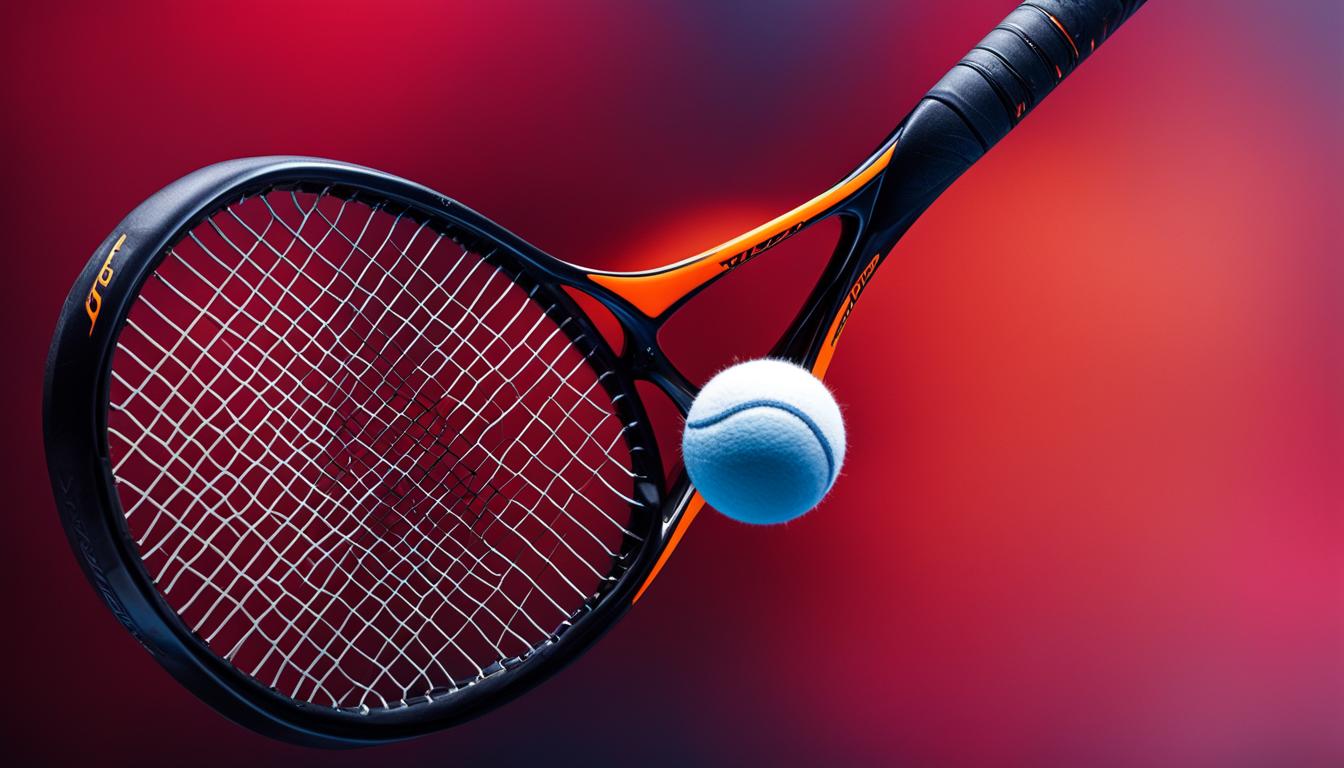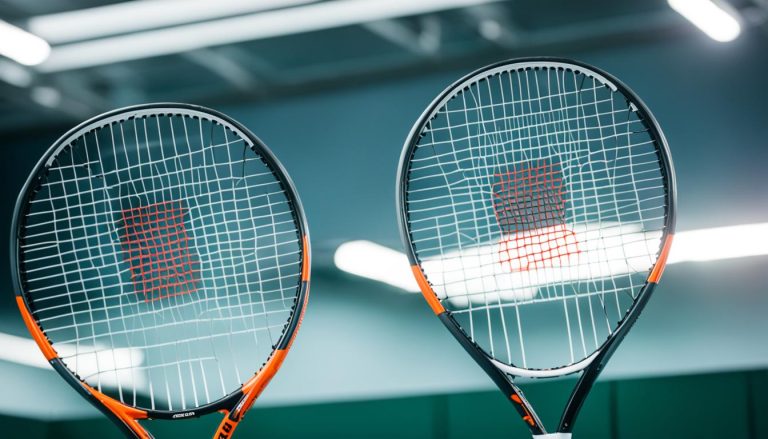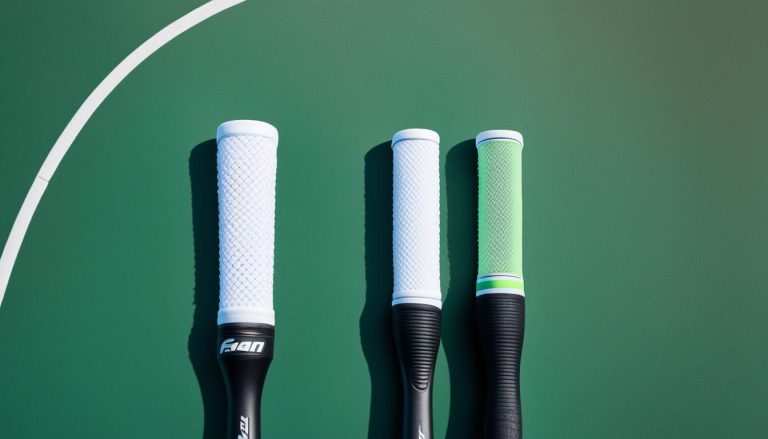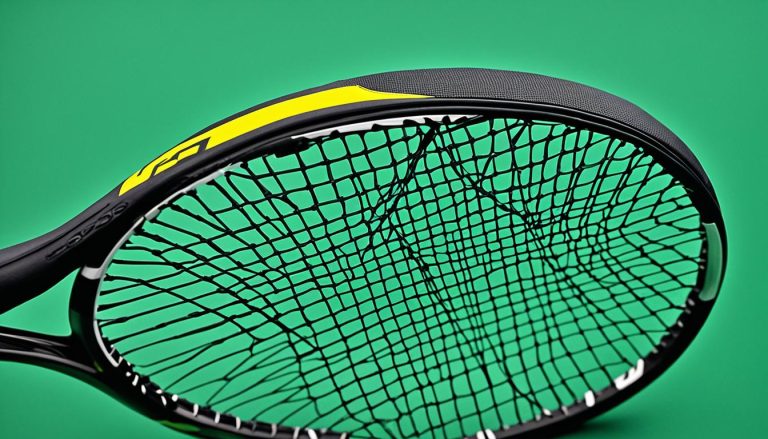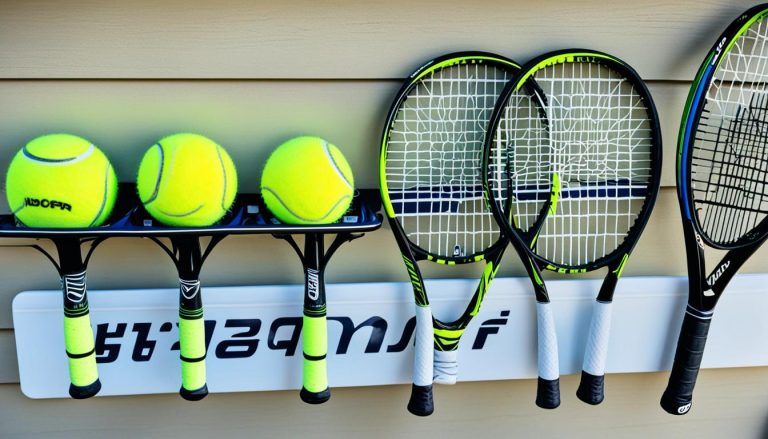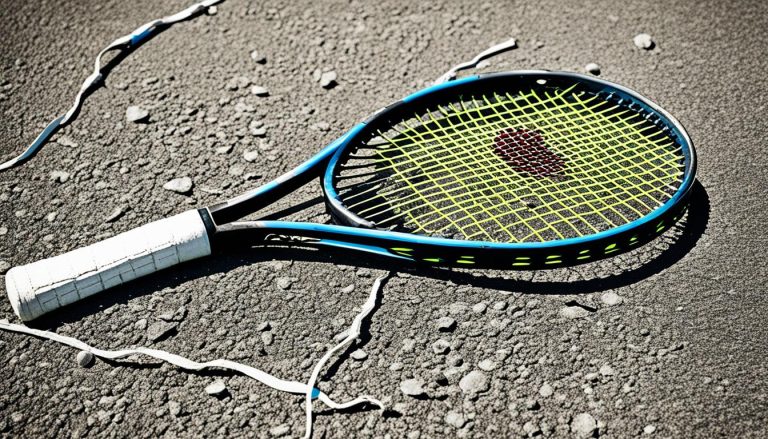The Importance of Vibration Dampeners in Tennis Rackets
Tennis is a sport that requires precision and control. Every little detail, from technique to equipment, can make a significant difference in a player’s performance. One often overlooked aspect of tennis equipment is the vibration dampener in tennis rackets. These small accessories play a vital role in enhancing the overall playing experience and can have a positive impact on a player’s game.
Vibration dampeners are specifically designed to reduce the vibration and shock that occurs when the tennis ball makes contact with the racquet strings. By absorbing and dispersing the energy, they help to minimize the vibrations felt by the player’s hand and arm, resulting in a more comfortable and controlled feel during gameplay. This reduction in vibration also helps to prevent arm fatigue and discomfort, allowing players to perform at their best for longer periods.
Furthermore, vibration dampeners have a direct effect on the sound and feel of the stringbed. They muffle the loud pinging sound that can occur upon impact, creating a more pleasant auditory experience. This sound reduction can also contribute to a player’s confidence on the court, as it provides a sense of control and precision.
It is important to note that vibration dampeners do not make tennis rackets more comfortable or arm-friendly. Instead, they enhance the overall feel and confidence of the player. Traditional dampeners are typically placed between the two main strings and under all the cross strings, while worm dampeners cover multiple main strings and should be evenly distributed. Despite their small size, dampeners weigh only 2-4 grams and have little to no impact on the playability of the racket.
According to the International Tennis Federation (ITF) regulations, dampeners can be placed anywhere outside the cross strings. However, over time, dampeners may stretch and wear, requiring periodic replacement to maintain their effectiveness.
Whether you are a professional player or a recreational enthusiast, investing in a quality vibration dampener for your tennis racket can greatly enhance your overall playing experience. From reducing vibrations to enhancing confidence on the court, these small accessories offer numerous benefits that can improve your game. So, don’t underestimate the importance of vibration dampeners and consider adding them to your tennis equipment arsenal.
How Vibration Dampeners Affect Your Game
Vibration dampeners can have a significant impact on the overall experience of playing tennis. While their primary function is to reduce the feel and sound of vibrations, they can also influence a player’s confidence on the court. Understanding the effects of vibration dampeners on your game is essential in optimizing your performance.
Contrary to popular belief, vibration dampeners do not reduce the actual impact on the arm. Instead, they primarily dampen the vibration of the strings, resulting in a more muted feel upon contact with the ball. The dampeners act as a buffer, absorbing some of the shock and preventing it from reaching the player’s arm. This can lead to a more comfortable playing experience, particularly for those prone to arm fatigue or discomfort.
Although vibration dampeners do not directly affect the swingweight of a racquet, they can provide a subtle increase of around 2 points. This slight adjustment in weight distribution can contribute to a player’s overall feel for the racquet and potentially enhance their strokes.
It’s important to note that vibration dampeners have no significant impact on playability. Their effects are primarily subjective and vary from player to player. Some players may find that dampeners boost their feel and confidence on the court, while others may not notice a noticeable difference. The choice to use a dampener ultimately comes down to personal preference and individual playing style.
Impact of Vibration Dampeners on Tennis Strokes
When it comes to the effect of dampeners on tennis strokes, there is no definitive answer. The use of a dampener can slightly alter the feel and feedback of each stroke, influencing a player’s timing and control. Some players may find that dampeners enhance their touch and precision, while others may feel that it negatively affects their stroke mechanics.
“Dampeners provide a more consistent feel and sound, which can bolster a player’s confidence and help them stay focused during a match.” – Coach Sarah Johnson
Coach Sarah Johnson emphasizes the psychological impact of using dampeners. By reducing the harshness of impact and creating a more pleasant sound, dampeners can contribute to an overall positive mental state on the court. This psychological boost can translate into more confident and composed play.
| Effect of Vibration Dampeners | Player Perspective |
|---|---|
| Feel and sound reduction | Enhanced comfort and confidence |
| No direct impact on arm fatigue | Potential relief for players with arm discomfort |
| Minimal effect on swingweight | Slight adjustment in racquet feel |
| Subjective impact on strokes | Personal preference and playing style dependent |
Common Misconceptions about Vibration Dampeners
Many tennis players hold certain misconceptions about vibration dampeners and their effects on the game. This section will debunk two prevalent myths and provide valuable insights on the effectiveness of dampeners in preventing tennis elbow.
Myth 1: Vibration Dampeners Prevent Tennis Elbow
One common misconception is that vibration dampeners can prevent tennis elbow. However, there is little scientific evidence to support this claim. Manufacturers often promote the idea that dampeners can reduce the risk of developing tennis elbow, but the reality is that racquets are already designed with built-in dampening features for enhanced shock absorption. While dampeners can enhance the feel and sound of the racquet, they do not significantly alter its play characteristics or provide significant arm protection against tennis elbow.
Myth 2: Vibration Dampeners Reduce a Racquet’s Power Level
Another misunderstanding is that vibration dampeners can decrease a racquet’s power level. Again, this notion lacks substantial evidence. Dampeners are typically small accessories placed near the middle of the string bed. Their primary function is to reduce string vibrations and mute the sound upon ball contact. They do not have a significant impact on a racquet’s power level. The power of a racquet is primarily determined by factors such as frame stiffness, string tension, and swing technique.
It’s important to note that using dampeners or alternative methods, such as rubber bands, may provide a placebo effect for some players. The perception of improved comfort and reduced vibration can have psychological benefits, leading to increased confidence on the court. However, it’s crucial to separate these psychological aspects from the objective physical effects of dampeners.
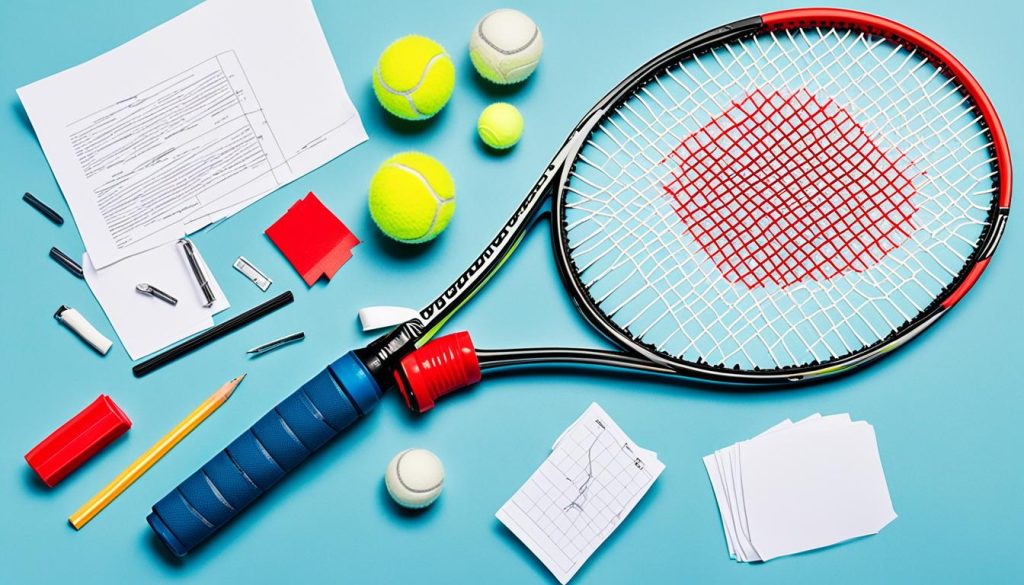
| Myth | Reality |
|---|---|
| Vibration dampeners prevent tennis elbow | Racquets already have built-in dampening features, and dampeners do not provide significant arm protection against tennis elbow. |
| Vibration dampeners reduce a racquet’s power level | Dampeners primarily reduce string vibrations and do not have a significant impact on a racquet’s power level. |
Placing Vibration Dampeners on Your Racquet
Proper placement of tennis dampeners is essential to maximize their effectiveness and comply with ITF rules. Here are some guidelines for placing the dampeners on your racquet:
- According to ITF rules, dampeners can be placed anywhere outside the pattern of the cross strings.
- Most players prefer placing dampeners towards the bottom of the racquet, where the center main string and first cross string meet. This location helps dampen vibrations effectively.
- While there is no strict limit on the number of dampeners that can be used, many players find one dampener sufficient.
- For traditional dampeners, they should be placed between the two main strings and under all the cross strings. This ensures even distribution of vibration reduction.
- Worm dampeners, on the other hand, should be evenly distributed between the main strings. This placement helps to balance the vibration control throughout the stringbed.
Properly placing the dampeners on your racquet not only enhances the comfort and feel but also ensures compliance with ITF rules. Experiment with different placements to find the configuration that suits your playing style and preferences.
| Type of Dampener | Placement |
|---|---|
| Traditional Dampeners | Between the two main strings and under all the cross strings |
| Worm Dampeners | Evenly distributed between the main strings |
Types of Vibration Dampeners
Vibration dampeners come in various shapes and designs, catering to different player preferences. Let’s explore the two main types of tennis dampeners: button dampeners and worm dampeners.
Button Dampeners
Button dampeners are popular among professional players and amateurs alike due to their ease of installation and wide availability. Resembling buttons, these dampeners can be conveniently attached to the strings of a tennis racket. They offer effective vibration reduction while also adding a touch of personal style to the racquet.
Worm Dampeners
Worm dampeners, on the other hand, are longer and require a bit more effort to install. They are woven between the main strings to provide vibration dampening. While they may take slightly more time to set up, their unique design allows for better coverage and distribution of shock absorption throughout the string bed. This can result in enhanced vibration reduction and a more consistent feel during gameplay.
| Dampener Type | Description |
|---|---|
| Button Dampeners | Resemble buttons, easy to install |
| Worm Dampeners | Longer and woven between main strings |
Both button and worm dampeners are typically made of rubber and serve the same purpose of reducing vibration in tennis rackets. The choice between the two mainly comes down to personal preference and desired level of vibration dampening.
Research on the Effectiveness of Vibration Dampeners
Research studies have shed light on the effectiveness of vibration dampeners in tennis rackets. While these accessories may not directly reduce frame vibration, they do have an impact on string vibrations. Experts suggest that players use dampeners not only for their acoustic effects but also for psychological support during intense matches.
Professional players, especially on the women’s WTA tour, frequently utilize vibration dampeners to enhance their game. According to statistics, 76% of female players in the WTA tour use dampeners, while 24% choose not to. On the men’s ATP tour, 58% of the top male professionals include dampeners in their equipment, while 42% prefer to play without them.
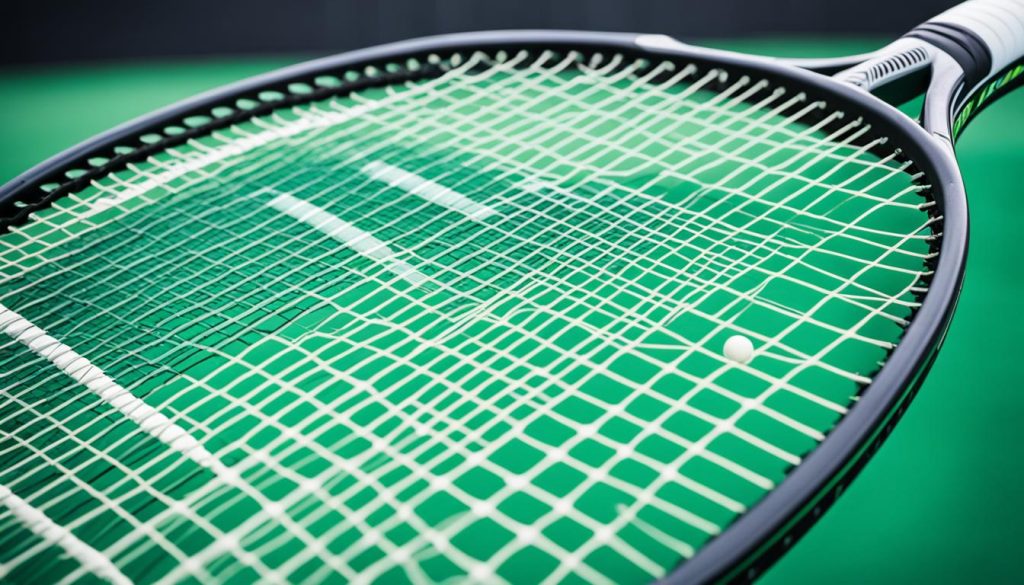
| Professional Tennis Tour | Percentage of Players Using Dampeners | Percentage of Players Not Using Dampeners |
|---|---|---|
| Women’s WTA Tour | 76% | 24% |
| Men’s ATP Tour | 58% | 42% |
Interestingly, some highly successful players have chosen not to use vibration dampeners. For example, both Roger Federer and Serena Williams, renowned tennis stars, do not incorporate dampeners into their game. This highlights the individual preferences and idiosyncrasies that players have when it comes to their equipment and playing style.
Trying Vibration Dampeners and Personal Preferences
When it comes to vibration dampeners in tennis, personal preference plays a significant role. Some players swear by them, finding that they enhance the sound and feel of their shots, while others prefer to play without them. Ultimately, trying out a dampener can help you determine if it enhances your comfort and confidence on the court.
Racquets with built-in dampening features can provide similar benefits without the need for additional accessories. These racquets are designed to reduce vibrations, providing a more comfortable and controlled playing experience. However, many players still prefer the extra customization and aesthetics that come with using a separate dampener.
Although vibration dampeners are often marketed as a solution for preventing tennis elbow or improving strokes, there is little scientific evidence to support these claims. The effectiveness of dampeners in preventing injuries or enhancing performance varies from player to player.
“I tried using a vibration dampener, and it made a noticeable difference in the sound and feel of my shots. It gave me a sense of increased control and confidence on the court.” – Emily, amateur tennis player
While the benefits of using a dampener may vary, one undeniable advantage is the added level of comfort it can provide. The dampener absorbs some of the vibration, reducing the harsh impact on the player’s arm. This can be particularly beneficial for players with sensitive joints or those prone to discomfort during prolonged play.
Visually, vibration dampeners can also add a touch of style to your racquet. They come in various colors, shapes, and designs, allowing you to customize your equipment and make a statement while playing.
Overall, trying out vibration dampeners is a personal decision. It’s worth exploring different options and experimenting with dampeners to see if they offer the desired benefits in terms of comfort and confidence. Remember that while dampeners may not have a proven impact on preventing injuries or improving strokes, they can be a comfortable and visually appealing addition to your racquet setup.
Players’ Perspectives on Vibration Dampeners
| Player | Opinion on Dampeners |
|---|---|
| Roger Federer | Does not use dampeners |
| Serena Williams | Does not use dampeners |
| Novak Djokovic | Uses dampeners |
| Ashleigh Barty | Uses dampeners |
| Rafael Nadal | Uses dampeners |
| Naomi Osaka | Uses dampeners |
Although top professional players like Roger Federer and Serena Williams do not use dampeners, many others, including Novak Djokovic, Ashleigh Barty, Rafael Nadal, and Naomi Osaka, find value in using them. This highlights the subjective nature of dampener preference and suggests that the benefits can vary from player to player.
Conclusion
After examining the role of vibration dampeners in tennis racquets, it can be concluded that these accessories primarily dampen string vibrations, resulting in an enhanced feel and sound. They have little impact on arm comfort, power level, or playability, making them a personal preference for players.
Considerations such as personal preferences and aesthetic appeal also factor into the decision to use dampeners. Trying out different types of dampeners can help players determine if they provide the desired benefits in terms of comfort and confidence on the court.
It is worth noting that the majority of top professional players, including Serena Williams and Roger Federer, use dampeners. While dampeners may not offer significant mechanical advantages, their widespread use among professionals suggests potential benefits in terms of feel and confidence on the court.
In conclusion, tennis racquet dampeners offer players the potential to enhance their playing experience through improved feel and sound. While they may not provide substantial mechanical advantages or prevent issues like tennis elbow, they remain a popular accessory among players of all levels. Ultimately, the decision to use dampeners depends on individual preferences and the desired playing experience.

